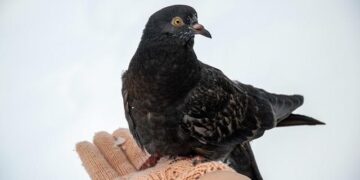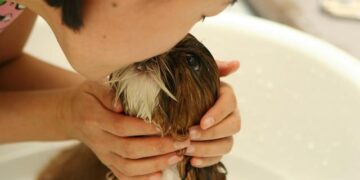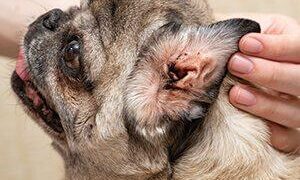Table of Contents
Introduction: The Unraveling of Normal
It began with a detail so small it was almost invisible.
On the sleek, black fur above my cat Luna’s left eye, a tiny, perfectly round patch of hair was simply… gone.
My first thought was that she’d had a minor scuffle with a doorframe or an overly ambitious bout of grooming.
It was nothing.
But a few days later, the patch was a little larger, the skin within it faintly scaly, like a miniature patch of desert on a landscape of velvet.
The quiet comfort of our shared life, a predictable rhythm of purrs and soft paws, had been subtly disturbed.
That disturbance sent me down the digital rabbit hole familiar to any worried pet owner.
The search results were a chaotic storm of conflicting advice.
Forum posts suggested everything from allergies to stress.
Lifestyle blogs offered “miracle” cures involving coconut oil and vinegar.
Then, interspersed among the casual advice, were more alarming terms: “contagious,” “fungus,” “quarantine.” My low-grade concern began to curdle into real anxiety.
The ambiguity was maddening.
The veterinarian’s office was an oasis of calm that did little to soothe my internal panic.
The vet examined Luna with a practiced gentleness before reaching for a handheld device.
In the darkened room, she switched on a Wood’s lamp, an ultraviolet light that cast an eerie purple glow.
And there it was: the patch on Luna’s face, and a few other hairs I hadn’t even noticed, lit up with an unholy, apple-green fluorescence.1
The vet explained that while the glow was highly suggestive, the gold standard for a definitive diagnosis was a fungal culture, a process that could take weeks.4
When she finally said the word “ringworm,” the world seemed to shrink to the size of that glowing patch.
The scientific name,
dermatophytosis, sounded even more alien and menacing.7
This wasn’t just a diagnosis for a rash; it was a declaration of a household invasion.
The initial shock of a ringworm diagnosis can feel like a catastrophe.
But what I came to understand is that a confirmed diagnosis is not a signal of defeat; it is the single most critical first step toward victory.
It ends the agonizing cycle of guesswork, the wasted money on ineffective remedies, and the escalating fear of the unknown.
An owner fighting a skin lesion without a proper diagnosis is fighting blind, seeing only a symptom while the fungal enemy silently multiplies and spreads its invisible spores throughout the home.7
The veterinarian’s diagnosis, confirmed by a culture, is a strategic map.
It identifies the enemy, reveals its tactics, and dictates the precise, proven counter-offensive required for success.
The fear of the diagnosis is real, but the clarity it provides is the first and most powerful weapon you will have.
Part I: Understanding the Siege – What Ringworm Is and Why It’s Not Just a “Rash”
To defeat an enemy, you must first understand it.
My battle with Luna’s ringworm began in earnest the moment I stopped seeing it as a simple skin problem and started seeing it for what it was: a microscopic siege.
Deconstructing the Invader: It’s a Fungus, Not a Worm
The first thing to understand is that ringworm has nothing to do with worms.
The name is a misnomer, derived from the classic, red, ring-shaped lesion that often appears on infected human skin.7
The actual culprit is a group of fungi called dermatophytes.
In cats, over 90% of cases are caused by a single species:
Microsporum canis.4
This is a parasitic organism that has evolved to do one thing exceptionally well: feed on keratin, the protein that makes up the dead, outermost layers of skin, hair, and claws.1
The Spore Apocalypse: The Invisible Enemy
The true horror of ringworm lies not in the visible lesions, but in the invisible method of its spread.
Dermatophytes produce microscopic reproductive units called arthrospores.
These spores are the fungal equivalent of seeds, and they are masters of survival.
They can remain viable in the environment—on carpets, furniture, bedding, grooming tools, and even in dust—for an astonishing 12 to 18 months.4
Transmission occurs through direct contact with an infected animal or, more insidiously, through contact with these environmental spores, known as fomites.4
A single infected hair shed from your cat can carry thousands of these spores, turning your entire home into a potential contamination zone.
This is the central fact that must inform your entire strategy: you are not just treating your cat; you are decontaminating your home.
Anatomy of an Infection: The Follicle Factory
A dermatophyte infection is not merely superficial.
When a spore lands on a cat’s skin, its hyphae (thread-like fungal structures) grow down along the hair shafts and invade the hair follicles.4
Inside the follicle, the fungus establishes a “factory,” producing a massive number of new spores that form a thick sheath around the hair shaft.
This process weakens the hair, causing it to become brittle and break off at the skin’s surface, which results in the characteristic patches of hair loss, or alopecia.4
While the “classic” lesion is a circular patch of alopecia, ringworm is a master of disguise.
It can present as irregular patches, widespread scaling and crusting (dandruff), or even raised, nodular bumps called kerions or pseudomycetomas, the latter being more common in long-haired breeds like Persians.1
Some cats, especially long-haired ones, can even be asymptomatic carriers, showing no signs of disease but actively shedding infectious spores into the environment.7
Risk Factors: Why My Cat?
While any cat can get ringworm, certain factors increase susceptibility.
The fungus needs a break in the skin’s defenses to establish an infection, so any minor scratch or abrasion can serve as an entry point.6
Kittens and young cats under a year old, whose immune systems are still developing, are at the highest risk.4
Long-haired cats, particularly Persians, are also predisposed, partly because their dense coats can trap spores and moisture, creating an ideal environment for fungal growth.6
This understanding—that you are fighting a microscopic, spore-shedding organism that has colonized your cat’s hair follicles and contaminated your entire living space—is the essential paradigm shift.
It moves the problem from the realm of “spot treatment” to the realm of “biocontainment”.13
The visible lesion on your cat is not the problem; it is merely evidence of the problem.
The true problem is the invisible “seed bank” of spores coating your cat’s entire body and every surface in your home.
Any strategy that fails to address this comprehensive reality is doomed from the start.
Part II: The Anatomy of Failure – My Chronicle of Ineffective Half-Measures
Before I embraced the logic of a full-scale war, I waged a series of foolish, losing skirmishes.
My journey through these failed attempts was a masterclass in frustration, false hope, and the slow, dawning horror of realizing I was making things worse.
The Siren Song of Spot Treatments
My first mistake was born of flawed logic.
Seeing a spot, I sought to treat the spot.
I purchased an over-the-counter antifungal cream—the kind marketed for human yeast infections or athlete’s foot, containing miconazole.15
I felt proactive and responsible as I diligently dabbed the cream onto Luna’s bald patch twice a day.
For a few days, I convinced myself it was working.
The scientific reality, however, was that my efforts were laughably inadequate.
This approach fails for three critical reasons.
First, it ignores the reality of asymptomatic shedding.
Luna was shedding infectious spores from her entire coat, not just the lesion I could see.7
While I was treating one tiny patch, she was contaminating the sofa, the rug, and her bedding with spores from her tail, her back, and her paws.
It was a futile game of whack-a-mole where I couldn’t even see the moles.17
Second, these topical creams do not effectively sterilize the hair coat.
They cannot reduce the overall spore load, meaning the cat remains a walking, purring fomite, a potent source of environmental re-contamination.18
Finally, and most importantly, the fungus resides deep within the hair follicle, a reservoir that topical creams have limited ability to penetrate and eradicate.4
I was merely trimming the leaves while the roots thrived underground.
The “Natural” Remedy Trap
When the cream failed to stop new spots from appearing, I turned back to the internet and fell into the “natural” remedy trap.
Well-meaning websites and forums suggested everything from apple cider vinegar to coconut oil.
Desperate, I tried them.
The result was an annoyed cat who smelled like a salad, and skin that became more irritated from the applications.
Expert veterinary consensus is clear: these home remedies are not only ineffective but can be actively harmful.
Some, like tea tree oil, are toxic to cats, while others can cause further skin irritation, creating more entry points for the fungus to exploit.18
The Turning Point: A House Under Siege
The crisis point arrived about three weeks into my failed campaign.
The lesions on Luna were now undeniably spreading across her face and ears.
And then, I saw it on my own arm: a small, itchy, perfectly circular red ring.
The zoonotic reality of ringworm had breached my own defenses.8
The fungus had jumped from my cat to me.
It was a moment of sickening clarity.
My half-measures, my spot treatments, and my wishful thinking had not only failed my cat, but they had also put my own health at risk.
The siege was no longer just on Luna; it was on me.
That was the moment I surrendered my own flawed strategies and committed, unequivocally, to the comprehensive battle plan laid out by my veterinarian.
The failure of these common approaches is not a reflection of a pet owner’s lack of effort or care.
It is the predictable outcome of a fundamentally flawed strategy.
The disconnect between the perceived problem—a simple rash—and the actual problem—a microscopic environmental siege—makes failure almost inevitable for anyone who deviates from a comprehensive, multi-pronged protocol.
The path of spot treatments and home remedies is a well-trodden road to frustration and a worsening infection.
Part III: The Three-Front War – The Blueprint for Total Eradication
With the hard-won knowledge that half-measures were useless, I embraced my veterinarian’s strategy: a relentless, three-front war.
This is not a list of options from which to pick and choose.
Victory demands that all three fronts—Systemic, Topical, and Environmental—be fought simultaneously, aggressively, and without pause until the enemy is completely eradicated.
Front 1: The Systemic Assault (Attacking from the Inside Out)
This is the primary offensive, targeting the fungus where it lives and reproduces: deep inside the hair follicles.
This internal attack is waged with oral antifungal medication, which circulates through the cat’s bloodstream to stop the fungus from replicating.8
The Weapon of Choice: Oral Antifungals
The cornerstone of modern feline ringworm treatment is itraconazole.
The veterinary formulation, sold under brand names like Itrafungol®, is the only systemic treatment specifically FDA-approved for dermatophytosis in cats.21
It is highly effective and has demonstrated a strong safety profile in felines.12
Its success is well-documented; one study showed that after a 5-week treatment course, 97.5% of itraconazole-treated cats achieved clinical cure, compared to only 15% in the untreated control group.23
The medication is often prescribed in a “pulse therapy” schedule (e.g., one week of daily dosing followed by one week off) that takes advantage of the drug’s ability to remain in the skin and hair at effective concentrations even during the “off” weeks.12
The commercially available liquid is also cherry-flavored, which significantly helps with administration.22
CRITICAL WARNING: The Compounding Catastrophe
In an effort to save money, some may be tempted to use a compounded version of itraconazole.
This is a dangerous and often ineffective choice.
Multiple veterinary sources and studies explicitly warn that compounded itraconazole has poor and unreliable bioavailability, meaning the cat’s body may not absorb enough of the drug to fight the infection.
Using it can lead directly to treatment failure, prolonging the infection and the period of environmental contamination.12 Insist on the FDA-approved veterinary formulation.
Table 1: Systemic Antifungal Arsenal
| Drug Name | Mechanism of Action | Common Brand(s) | Veterinary Notes & Efficacy | Common Side Effects |
| Itraconazole | Inhibits ergosterol synthesis, a key component of the fungal cell membrane, causing the cell to die.21 | Itrafungol®, Sporanox® | The only oral antifungal FDA-approved for cats; considered the drug of choice due to high efficacy and safety.21 | Decreased appetite, vomiting, diarrhea. Liver toxicity is rare but possible.21 |
| Terbinafine | Also inhibits ergosterol synthesis, but at a different point in the pathway. | Lamisil® | Highly effective alternative. Studies show it can resolve infection in cats within weeks when combined with topical therapy.25 | Generally well-tolerated in cats. Gastrointestinal upset is the most common side effect.7 |
| Griseofulvin | Disrupts fungal cell division. | Fulvicin® | The traditional treatment, but now less commonly used in cats due to a higher risk of side effects, including bone marrow suppression.8 | Vomiting, diarrhea, lack of appetite. Can cause serious side effects and should not be used in pregnant cats or those with FIV.7 |
Front 2: The Topical Campaign (Sterilizing the Exterior)
While the oral medication attacks from the inside, the topical campaign fights from the outside.
Its primary goal is not to cure the deep infection, but to kill the fungal spores on the hair coat.
This is a critical step to shut down the “spore factory,” drastically reducing the number of infectious particles shed into the environment and preventing the cat from reinfecting itself and others.18
The Gold Standard: Lime Sulfur Dip
Of all available topical therapies, lime sulfur solution is consistently cited as the most effective for sterilizing the coat.18
My first encounter with it was memorable for all the wrong reasons: the potent “rotten egg” smell that permeated the bathroom, the temporary yellow staining of Luna’s white patches and my towels, and the general unpleasantness of the task.8
But its effectiveness is undeniable.
It has residual activity, meaning it continues to work on the coat for days after application, and it is the fastest way to render the cat non-contagious.30
It is a necessary hardship on the path to victory.
The Lime Sulfur Dip: A Step-by-Step Survival Guide
- Preparation: Work in a well-ventilated area (like a bathroom with an exhaust fan).29 Wear old clothes, waterproof gloves, and remove all jewelry, as lime sulfur will stain fabric and tarnish metal.32
- Dilution: Mix the solution in a dedicated plastic container, not directly in your sink or tub. The recommended concentration for maximum efficacy is 8 ounces of lime sulfur concentrate per 1 gallon of warm water (a 1:16 ratio). This is often double the strength listed on the bottle instructions but is the standard for shelter medicine protocols.28
- Application: Do NOT pre-wet the cat.33 To minimize stress, avoid dunking the cat. Instead, use a new, clean garden sprayer with a fine mist setting to apply the solution, keeping the nozzle close to the skin to ensure the entire coat is saturated.30 Use a separate sponge or cotton ball to carefully apply the solution to the face, ears, and chin, being extremely careful to avoid the eyes, nose, and mouth.30 Keep a bottle of sterile eye flush on hand just in case of accidental contact.28
- Post-Application: Do NOT rinse the solution off.33 Gently towel dry the cat to remove excess liquid, then place her in a warm, draft-free space (like a carrier with a heating pad set on low under one half of it) to air dry completely. This is crucial to prevent chilling.29 An Elizabethan collar (e-collar) is generally not necessary, as minor licking of the dried solution is not considered harmful.30
- Frequency: Perform the dip twice weekly throughout the entire treatment period.25
Front 3: The Environmental Offensive (Operation Clean Sweep)
This is the most laborious front, but it is non-negotiable.
Failure here will lead to reinfection and prolong the ordeal indefinitely.
The goal is to systematically reduce the environmental spore load to zero.7
Phase 1: Isolation (Setting up the Biocontainment Unit)
The first and most important step is to contain the fallout.
The infected cat must be confined to a single, easily-cleaned room, such as a bathroom with a tile floor and minimal furnishings.9
This becomes your “biocontainment unit.” It prevents spores from spreading throughout the house and makes the daily cleaning effort manageable.
Any items in that room that cannot be repeatedly and thoroughly disinfected—especially porous items like carpeted cat trees, fabric toys, and cardboard scratchers—must be sealed in a plastic bag and discarded.36
Phase 2: The Decontamination Protocol
The cardinal rule of environmental decontamination is: Clean First, Then Disinfect. Fungal spores are protected by hair and organic debris.
Most disinfectants are inactivated by this material, so you must physically remove it first for the disinfectant to work.9
Use a vacuum cleaner with a bag that can be disposed of frequently, or use disposable electrostatic cloths (like Swiffer®) which trap hair and dust without aerosolizing spores.9
Once surfaces are physically clean, apply an effective disinfectant.
Proven agents include a 1:32 dilution of household bleach (1/2 cup bleach per gallon of water) or accelerated hydrogen peroxide products like Rescue™.31
The disinfectant must remain wet on the surface for a minimum of 10 minutes to kill the spores.31
Table 2: The Ultimate Environmental Decontamination Checklist
| Surface/Item | Mechanical Cleaning (Step 1) | Disinfection (Step 2) | Frequency | Special Notes |
| Hard Floors (Tile, Vinyl, Sealed Wood) | Vacuum or use electrostatic wipe daily.9 | Wash with detergent, then apply 1:32 bleach or Rescue™ solution. Let sit for 10 min contact time, then wipe/rinse.31 | Daily wipe-down, twice-weekly full disinfection. | Bleach can damage some surfaces; test in an inconspicuous area first.9 |
| Carpets / Area Rugs | Vacuum daily. Discard vacuum bag frequently (weekly minimum).9 | Professional steam cleaning is best. For DIY, use a carpet shampooer with a disinfectant rated for fungus, following mechanical cleaning.9 | Daily vacuuming is essential. Deep clean weekly. | Hot water extraction cleaners must reach >110°F to be effective via heat.38 |
| Upholstered Furniture | Vacuum daily. Use a lint roller or duct tape to remove stubborn hairs.9 | Cover with a washable sheet/blanket and launder it frequently. For the furniture itself, steam cleaning is the most effective option.9 | Daily vacuuming. Launder covers 2-3 times per week. | Confining the cat is the best way to protect furniture. |
| Bedding, Towels, Clothing | Handle soiled laundry with gloves. Place directly into the washing machine or a sealed plastic bag.9 | Wash separately from other household laundry. Use detergent and the longest, hottest wash cycle possible. Do not overload the machine. Dry completely in a dryer.9 | Change and wash daily. | The mechanical action of the wash is more important than bleach, but bleach can be added for white fabrics.9 |
| Cat Carrier, Food/Water Bowls, Litter Box | Wipe down carrier daily. Wash food/water bowls daily. Scoop litter box daily. | Disinfect carrier with bleach/Rescue™ solution weekly. Wash bowls in hot, soapy water or dishwasher.9 Empty, scrub, and disinfect litter box weekly. | Daily. | Use disposable litter pan liners to make cleaning easier. |
| Cat Trees & Porous Scratchers | N/A | These items are notoriously difficult to decontaminate effectively. | N/A | The safest and most highly recommended course of action is to discard them. Replace them only after the cat is confirmed cured.36 |
Part IV: Demobilization and De-Stressing – Life After Ringworm
Winning the war against ringworm is a marathon, not a sprint.
The final phase is as critical as the first, involving careful verification of the cure, a final decontamination sweep, and acknowledging the psychological toll of the ordeal.
Confirming Victory: The Cure is Mycological, Not Visual
This is perhaps the most crucial lesson for a pet owner to learn: just because your cat’s fur has grown back and the lesions have disappeared (a clinical cure), it does not mean the infection is gone.2
The cat can still be an asymptomatic carrier, silently shedding spores and capable of causing a relapse or infecting others.
Stopping treatment too early based on visual improvement is the single most common reason for recurrence.7
The true finish line is a mycological cure.
This is a scientific standard, not a visual one.
It is defined by obtaining two consecutive negative fungal cultures, typically performed one to two weeks apart.7
You must continue all three fronts of the war—especially the oral medication and topical dips—until your veterinarian, guided by these culture results, officially declares your cat cured.
The Psychological Toll and Recovery
Living through a ringworm outbreak is exhausting.
It’s a relentless cycle of cleaning, medicating, and worrying.
The constant smell of lime sulfur, the financial cost of vet visits and medications, and the feeling of living in a sterile, isolated bubble take a significant psychological toll.
It is important to acknowledge this stress.
The journey is difficult, but it is finite.
The joy and relief that come with the first negative culture result are immense.
The second negative result feels like liberation.
It’s the signal that you can begin to dismantle the biocontainment unit and slowly, carefully, reclaim your home and your normal life with your beloved P.T.
Reclaiming Your Home: The Final Deep Clean
Once your veterinarian has confirmed a mycological cure, it is time for one final, thorough decontamination of your entire home before allowing your cat full access again.40
This is your insurance policy against any stray spores that may have survived.
Repeat the full “Operation Clean Sweep” protocol—vacuuming, cleaning, and disinfecting all surfaces, steam cleaning carpets, and laundering all fabrics—throughout the entire house.
Replace your HVAC air filter.
This final push ensures that the environment is as clean as your cat, breaking the cycle of infection for good.
Conclusion: Lessons from the Biohazard Zone
My journey with Luna from a single bald patch to a full-blown household biocontainment effort taught me more than I ever wanted to know about dermatophytes.
But it also forged a clear, unwavering understanding of what it takes to win.
The battle is arduous, smelly, and expensive, but with the right strategy, it is 100% winnable.
The core principles for victory are absolute:
- Change Your Mindset: Ringworm is a serious environmental contamination event, not just a simple skin rash on your cat.
- Start with a Diagnosis: Do not guess. A veterinarian’s diagnosis, confirmed by a fungal culture, is the essential first step that provides the blueprint for your entire campaign.
- Reject Half-Measures: Spot treatments, “natural” remedies, and incomplete cleaning are guaranteed to fail, prolonging the infection and increasing the risk of spread.
- Wage a Three-Front War: Success requires the simultaneous and relentless application of all three strategies: systemic oral medication to kill the fungus internally, topical therapy to sterilize the coat, and aggressive environmental decontamination to eliminate spores.
- Trust Science, Not Sight: The finish line is a mycological cure confirmed by your veterinarian through negative cultures, not the simple disappearance of lesions.
The memory of the glowing green hairs and the smell of sulfur will fade.
What remains is the peace of a reclaimed home, and Luna, her coat a seamless expanse of black, purring contentedly on a clean, fungus-free couch—a hard-won, and deeply cherished, symbol of victory.
Works cited
- Feline dermatophytosis: Clinical features and diagnostic testing – PMC – PubMed Central, accessed August 12, 2025, https://pmc.ncbi.nlm.nih.gov/articles/PMC7560770/
- Ringworm: A Serious but Readily Treatable Affliction, accessed August 12, 2025, https://www.vet.cornell.edu/departments-centers-and-institutes/cornell-feline-health-center/health-information/feline-health-topics/ringworm-serious-readily-treatable-affliction
- Diagnosing Ringworm – Shelter Medicine – UW–Madison, accessed August 12, 2025, https://sheltermedicine.wisc.edu/library/guidebooks/ringworm/diagnosing-ringworm
- GUIDELINE for Dermatophytosis, ringworm in cats – ABCD cats & vets, accessed August 12, 2025, https://www.abcdcatsvets.org/guideline-for-dermatophytosis-ringworm-in-cats/
- Dermatophytosis in Dogs and Cats – Integumentary System – MSD Veterinary Manual, accessed August 12, 2025, https://www.msdvetmanual.com/integumentary-system/dermatophytosis/dermatophytosis-in-dogs-and-cats
- Ringworm in Cats – International Cat Care, accessed August 12, 2025, https://icatcare.org/articles/ringworm-in-cats
- Ringworm in Cats – PetMD, accessed August 12, 2025, https://www.petmd.com/cat/conditions/skin/ringworm-in-cats
- Ringworm in Dogs and Cats – Veterinary Partner – VIN, accessed August 12, 2025, https://veterinarypartner.vin.com/doc/?id=4951439&pid=19239
- Ringworm Environmental Decontamination: How to Clean Your …, accessed August 12, 2025, https://veterinarypartner.vin.com/default.aspx?pid=19239&id=7058488
- Dermatophytosis in cats: ABCD guidelines on prevention and management – PubMed, accessed August 12, 2025, https://pubmed.ncbi.nlm.nih.gov/23813824/
- Feline dermatophytosis: Aspects pertinent to disease management in single and multiple cat situations – PubMed Central, accessed August 12, 2025, https://pmc.ncbi.nlm.nih.gov/articles/PMC4361704/
- Dermatophytosis in Dogs and Cats – Integumentary System – Merck Veterinary Manual, accessed August 12, 2025, https://www.merckvetmanual.com/integumentary-system/dermatophytosis/dermatophytosis-in-dogs-and-cats
- Biocontainment – Wikipedia, accessed August 12, 2025, https://en.wikipedia.org/wiki/Biocontainment
- A Brief History of Biocontainment – PMC, accessed August 12, 2025, https://pmc.ncbi.nlm.nih.gov/articles/PMC7099915/
- How to Help Kittens with Ringworm – Kitten Lady, accessed August 12, 2025, http://www.kittenlady.org/ringworm
- Ringworm – Don’t Panic – AZ CARE Rescue, accessed August 12, 2025, https://azcarerescue.org/tips/ringworm/
- Why Spot Treating Doesn’t Cure Ringworm in Cats – YouTube, accessed August 12, 2025, https://www.youtube.com/watch?v=a9HlZutwGzY
- Treating Ringworm – Shelter Medicine – UW–Madison, accessed August 12, 2025, https://sheltermedicine.wisc.edu/library/guidebooks/ringworm/treating-ringworm
- Ringworm (Tinea Corporis): What It Looks Like, Causes & Treatment – Cleveland Clinic, accessed August 12, 2025, https://my.clevelandclinic.org/health/diseases/4560-ringworm
- Ringworm in Cats – Maddie’s Fund, accessed August 12, 2025, https://www.maddiesfund.org/kb-ringworm-in-cats.htm
- Itraconazole Antifungal for Cats With Ringworm and Fungal Disease – GoodRx, accessed August 12, 2025, https://www.goodrx.com/pet-health/cat/itraconazole
- Itrafungol (Itraconazole) Oral Solution for Cats 10 mg/ml, 52 ml – PetSmart, accessed August 12, 2025, https://www.petsmart.com/pharmacy/cat/antifungal/itrafungol-itraconazole-oral-solution-for-cats-10-mgml-52-ml-66926.html
- Efficacy of itraconazole oral solution using an alternating-week pulse therapy regimen for treatment of cats with experimental Microsporum canis infection – PMC, accessed August 12, 2025, https://pmc.ncbi.nlm.nih.gov/articles/PMC6158682/
- Itrafungol Oral Solution – Pets First Choice, accessed August 12, 2025, https://petsfirstchoicerx.com/product/itrafungal-oral-solution/
- Ringworm Treatment – Shelter Animal Physical Health – University of Florida Pressbooks, accessed August 12, 2025, https://ufl.pb.unizin.org/shelteranimalphysicalhealth/chapter/ringworm-treatment/
- Itraconazole | VCA Animal Hospitals, accessed August 12, 2025, https://vcahospitals.com/know-your-pet/itraconazole
- Dont let ringworm run rings around your veterinary patients – DVM360, accessed August 12, 2025, https://www.dvm360.com/view/don-t-let-ringworm-run-rings-around-your-veterinary-patients
- Treating Ringworm – Koret Shelter Medicine Program, accessed August 12, 2025, https://www.sheltermedicine.com/library/guidebooks/ringworm/treating-ringworm
- Lime Sulfur Topical | VCA Animal Hospitals, accessed August 12, 2025, https://vcahospitals.com/know-your-pet/lime-sulfur-topical
- Ask the expert: Ringworm treatment | HumanePro by Humane World for Animals, accessed August 12, 2025, https://humanepro.org/magazine/articles/ask-expert-ringworm-treatment
- What is the most effective way to resolve ringworm in my foster kittens?, accessed August 12, 2025, https://www.sheltermedicine.com/library/resources/what-is-the-most-effective-way-to-resolve-ringworm-in-my-foster-kittens
- Lime Sulfur Dip for Animal Use – Drugs.com, accessed August 12, 2025, https://www.drugs.com/vet/lime-sulfur-dip.html
- A Foster Parent’s Guide to Ringworm, accessed August 12, 2025, https://phillypaws.org/wp-content/uploads/Foster-Parents-Guidelines-for-Treating-Ringworm-9-July-2019.pdf
- Lime Sulfur Dip Protocol, accessed August 12, 2025, https://sheltermedicine.vetmed.ufl.edu/wordpress/files/2022/03/Lime-Sulfur-Dip-Protocol.pdf
- Feline Ringworm Diagnosis and Treatment Gatorland Animal Services SOPs, accessed August 12, 2025, https://sheltermedicine.vetmed.ufl.edu/wordpress/files/2022/03/Gatorland-Ringworm-Diagnosis-and-Treatment-SOP.pdf
- Cat Ringworm: Signs, Spread, Diagnosis, Treatment – Best Friends Animal Society, accessed August 12, 2025, https://bestfriends.org/pet-care-resources/cat-ringworm-signs-spread-diagnosis-treatment
- Dermatophytosis (Ringworm) Protocol for Foster-Based Programs – ASPCApro, accessed August 12, 2025, https://www.aspcapro.org/sites/default/files/2020-07/ringworm-protocol-for-la-foster-aspcapro.pdf
- Environmental Decontamination – Shelter Medicine – UW–Madison, accessed August 12, 2025, https://sheltermedicine.wisc.edu/library/guidebooks/ringworm/environmental-decontamination
- Cleaning and Disinfecting Foster Homes During a Ringworm Outbreak – Shelter Medicine, accessed August 12, 2025, https://sheltermedicine.wisc.edu/library/resources/cleaning-and-disinfecting-foster-homes-during-a-ringworm-outbreak
- Managing Ringworm in a Foster Home or Private Home – Shelter Medicine – UW–Madison, accessed August 12, 2025, https://sheltermedicine.wisc.edu/library/guidebooks/ringworm/managing-ringworm-in-a-foster-home-or-private-home
- how to deal with ringworm cleaning after cat got ringworm? : r/CatAdvice – Reddit, accessed August 12, 2025, https://www.reddit.com/r/CatAdvice/comments/1123ah6/how_to_deal_with_ringworm_cleaning_after_cat_got/
- Ringworm: How to Clean and Disinfect Effectively with Rescue, accessed August 12, 2025, https://dashboard.rescuedisinfectants.com/ringworm-how-to-clean-and-disinfect-effectively-with-rescue/
- Ringworm (Dermatophytosis) – Shelter Medicine – UW–Madison, accessed August 12, 2025, https://sheltermedicine.wisc.edu/library/resources/ringworm-dermatophytosis
- Skin Fungal Infections in Cats – PetMD, accessed August 12, 2025, https://www.petmd.com/cat/conditions/skin/skin-fungal-infections-cats






